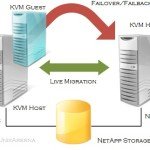This article will help you to setup High Availability NFS server using Pacemaker on Redhat Enterprise Linux 7. From the scratch ,we will build the pacemaker blocks which includes package installation , configuring the HA resources, fencing etc. NFS shares are used for setting up the home directories and sharing the same content across multiple […]
Pacemaker
RHEL7 – Configuring GFS2 on Pacemaker/Corosync Cluster
This article will briefly explains about configuring the GFS2 filesystem between two cluster nodes. As you know that GFS2 is cluster filesystem and it can be mounted on more than one server at a time . Since multiple servers can mount the same filesystem, it uses the DLM (Dynamic Lock Manager) to prevent the data corruption. […]
RHEL 7 – How to configure the Fencing on Pacemaker ?
Fencing (STONITH) is an important mechanism in cluster to avoid the data corruption on shared storage. It also helps to bring the cluster into the known state when there is a split brain occurs between the nodes. Cluster nodes talks to each other over communication channels, which are typically standard network connections, such as Ethernet. Each […]
RHEL 7 – Accessing the Pacemaker WEB UI (GUI) – Part 11
Pacemaker offers web based user interface portal to manage the cluster. It also provides an interface to manage multiple clusters in single web UI. We can’t really say that WEB UI has all the options to manage the cluster. I would say that command line is much easier and simple when you compare to GUI. However , […]
RHEL 7 – Pacemaker – Configure Redundant Corosync Links on Fly– Part 10
Corosync cluster engine provides the reliable inter-cluster communications between the cluster nodes. It syncs the cluster configuration across the cluster nodes all the time. It also maintains the cluster membership and notifies when quorum is achieved or lost. It provides the messaging layer inside the cluster to manage the system and resource availability. In Veritas cluster , this functionality has […]
RHEL 7 – Pacemaker – Define the Resource Behaviour – Part 9
In Pacemaker/Corosync cluster, there are may aspects/key elements that we need to understand before playing with cluster operations. Otherwise , it might cause unnecessary outage/downtime for the services. The most important elements are setting the preferred resource location , ordering (defining dependencies) , resource fail counts, resource-stickiness, colocation, clone, master/slave, promote/demote etc. Let’s go through the article and […]
RHEL 7 – Pacemaker – Cluster Node Management – Part 8
This article will demonstrates about the Pacemaker/Corosync cluster membership, node management and other cluster operational tasks. Periodically , you might need to take the cluster node offline to perform the maintenance activities like OS package update/upgrade , hardware replacement/upgrade etc. In such cases ,you need to put the cluster node in to standby mode to keep the […]
RHEL 7 – Pacemaker – Configuring HA KVM guest – Part 7
If you have followed the KVM article series in UnixArena , you might have read the article which talks about the KVM guest live migration. KVM supports the Guest Live migration (similar to VMware vMotion) but to provide high availability , you need need a cluster setup . (Like VMware HA). In this article ,we […]
RHEL 7 – Pacemaker – Cluster Resources/Group Management – Part 6
In Pacemaker/Corosync cluster (RHEL 7 HA), resources management and resource group management are important tasks . Depends on the cluster HA services, you might need to configure N-number of resources. In most of the cases , you might need to start set of resources sequentially, and stop in the reverse order. To simplify this configuration, Pacemaker supports […]
RHEL 7 – Pacemaker – Cluster Resource Agents Overview – Part 5
Resource agents plays an important role in cluster management. Resource agents are multi-threaded processes that provides the logic to manage the resources. Pacemaker has one agent per resource type. Resource type could be a File-system , IP address , databases, virtual-domain and more. Resource agent is responsible to monitor, start , stop,validate , migrate , promote and demote […]








